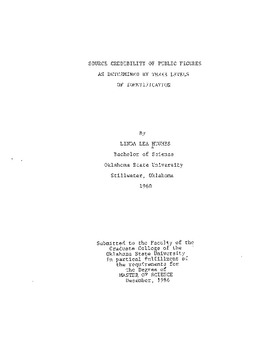| dc.description.abstract | Source credibility studies over the past three decades have dealt primarily with the effect of the speaker upon the message. However, with new sources in the form of persons and organizations appearing almost daily on broadcasts and in pri' nt, the use of identification for source credibility has become increasingly valuable. It would appear that virtually anyone in this democratic nation can project himself or herself in the public's eye as an expert, particularly in the area of political issues. But just which type of identification gives the greatest credence to the speaker or source? Is it possible that with such a constant barrage of faces and names the public has become more selective and more critical of the types of identification used to describe sources? Today's mass-media journalists generally use a person's name and organizational affiliation as a basic identification; however, a few decades ago, the more education a person had, the greater credibility he had with an audience, perhaps because he was considered to be more competent and more expert. What does this shift in identification emphasis mean in terms of audience perceptions? This study sought to learn more about this and other questions. It compared three variations of identification-- Biographical with name, education, professional achievements, and personal data; Socio-cultural with name, title or rank, and organization or group affiliation; and Occupational with name and occupation only--in order to determine which of the three held the greatest credibility for an audience, The effect upon the variables of respondent sex, age, and education was measured. Spokespersons from the women ��s rights issues were selected as the sources tested, because these particular political issues created consider.able public discussion in the recent past. The issues were, according to the spokespersons, going to have a d, irect effect upon every male and female in the country. Sources representing metropolitan and suburban areas, religious, feminist, and political activist groups as well as political, government and business officials all purported to be credible speakers on the issues involved in women's rights. The public's acceptance of that supposed credibility and the levels involved had not been studied. Therefore, this study will seek to enlighten those interested in the credibility of public figures, The study was intended to reflect those specific segments of the population which are most receptive to each type of identification--Biographical, Socio-cultural, or Occupational. Sex, age, and education levels were the independent variables used for the research. Even the general topic of women's rights, in certain instances was provocation enough to brin�g forth irate reactions directed at the researcher. The study was, if not significant in the research data presented, at least interesting as a study in human emotions. | |
